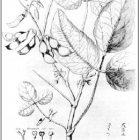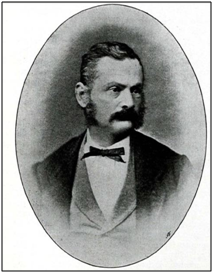
Portrait of Friedrich Haberlandt, c. 1870
Portrait of Friedrich Haberlandt, c. 1870
Click here for BOKU image source.
 This work is licensed under a Creative Commons Public Domain Mark 1.0 License.
This work is licensed under a Creative Commons Public Domain Mark 1.0 License.
One of the attractions at the 1873 Viennese World’s Fair was the exhibition of the Japanese Empire. The exhibits included Japanese flora, among them soybean plants. The soybean had been part of Japanese and other East Asian food cultures for many centuries. These strange plants caught the attention of the Austrian botanist Friedrich Haberlandt (born 1826 in Bratislava, died 1878 in Vienna). As an agricultural scientist, he became curious about the potential of this alien crop for domestic cultivation. Thus, he purchased sample seeds, most of them from China, in order to conduct cultivation experiments in various regions of the Austro-Hungarian Monarchy.
In his book Die Sojabohne: Ergebnisse der Studien und Versuche über die Anbauwürdigkeit dieser neu einzuführenden Culturpflanze (1878), Haberlandt enthusiastically promoted the introduction of the soybean plant in domestic agriculture. The soybean could be successfully cultivated in Central Europe due to its high adaptability to different climate and soil conditions. Moreover, Haberlandt praised the soybean’s exceptional nutritional value, especially its high protein and fat content. He strongly emphasized the soybean’s twofold importance for the “general welfare of the people” (allgemeine Volkswohlfahrt), both directly, as human food, and indirectly, as animal feed. Haberlandt envisioned the transfer of an integral element of Eastern food cultures to the West. However, his vision was framed by a Eurocentric point of view: instead of adopting time-consuming Asian cooking styles, he proposed grinding the beans and adding the resulting meal to other ingredients according to European culinary conventions. In short, the “oriental” element should be integrated into—and, thus, subordinated to—the “occidental” food culture.
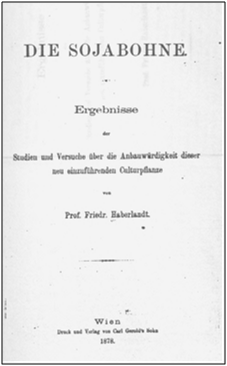
Cover of Haberlandt’s Die Sojabohne, 1878
Cover of Haberlandt’s Die Sojabohne, 1878
Click here to view Hathi Trust image source.
 This work is licensed under a Creative Commons Public Domain Mark 1.0 License.
This work is licensed under a Creative Commons Public Domain Mark 1.0 License.
Haberlandt was not the first Western scientist to deal with the beans from the Far East. However, the soybean did not enter European food cultures prior to the late nineteenth century. One reason was the failure of efforts to cultivate late-maturing soybean varieties on European fields, which mostly fell victim to autumn frosts. Another reason was the successful adoption of crops of American origin, which improved European diets: maize and potatoes. Thus, Haberlandt did not discover the soybean in late nineteenth-century Europe, but rediscovered it. More precisely, he recognized the suitability of early-maturing soybean varieties to the environmental conditions of Central European agriculture, as well as the bean’s high nutritional value for humans. But most importantly, he effectively disseminated his findings through his writings and lectures in the scientific community and beyond. Although Haberlandt died in 1878, his vision had already attracted followers from both academia and civil society.
Why did Haberlandt’s vision gain considerable attraction in fin de siècle Europe? After Europe’s agrarian societies had been caught for centuries in the “Malthusian trap” of periodic famines, they found two ways out of this trap: First, the improvement of the nutrient flows in the traditional farming system by using nitrogen-fixing crops such as clover and additional manure from barn-held livestock raised the productivity of agricultural land. Second, the access to the “subterranean forest” of coal provided European countries with the energy and technology that made it possible to acquire additional foodstuffs from overseas settler colonies for their fast-growing domestic populations. The provision of cheap food on a global scale was coordinated by the emerging nation-state in charge of “public nutrition” (Volksernährung).
Feeding Europe’s industrializing nations was not only a question of quantity, but also one of quality. According to the German chemist Justus von Liebig, protein as a sort of “embodied fuel” provided the main energetic source of muscular strength. While Liebig’s protein dogma was widely undisputed, nutritionists quarreled about the adequate sources of protein. While vegetarian intellectuals preferred protein from leguminous plants, other experts argued that animal protein from meat would most effectively fuel the (white, male and middle-class) body. In popular debates, meat-rich diets became associated with values such as “strength” and “wealth.”
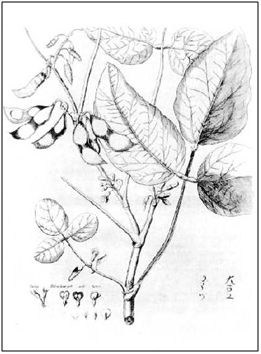
Illustration of a soybean plant by Engelbert Kaempfer, 1712
Illustration of a soybean plant by Engelbert Kaempfer, 1712
Click here to view Soy Info Center image source.
 This work is licensed under a Creative Commons Public Domain Mark 1.0 License.
This work is licensed under a Creative Commons Public Domain Mark 1.0 License.
Haberlandt’s vision of soy’s integration into European food cultures conformed to these debates: soy would improve arable farming and animal husbandry, as a nitrogen-fixing plant and protein-rich feedstuff, as well as human nutrition, as a direct or (via livestock feed) indirect source of cheap plant protein. Against this backdrop, Haberlandt’s vision was compatible with powerful discourses of his lifetime and after. However, his vision of soy as an element of food culture simultaneously clashed with the emerging preference for animal protein. Up to the mid-nineteenth century, meat-rich diets had been restricted mainly to the aristocracy and bourgeoisie. In the course of industrialization, falling food prices and rising purchasing power enabled working-class families not only to afford more foodstuffs, but also to shift from a cheap plant-based diet rich in carbohydrates to a costlier—but more prestigious—animal-based diet rich in proteins. Eating meat became constitutive of the image of the white, male, and well-to-do worker. Within this hegemonic discourse, there was not much room for soy.
Despite the limited success of Haberlandt’s vision in the prewar era, the “age of extremes” from 1914 to 1945 created renewed demand for cheap supplies of protein. Ensuring national food security became a prime goal of the interventionist state, while simultaneously mobilizing for a “total war” or struggling with a “great depression.” Nutritionists in collaboration with state agencies and food companies promoted soy flour as a cheap “ersatz” version of scarce foodstuffs. Germany in particular, most aggressively engaged in the two world wars and most severely hit by the world-economic crisis, made efforts to exploit soy’s nutritional potential. Nazi Germany enforced soybean cultivation in Southeast Europe and distributed soy-based rations among its soldiers; thus, the Western Allies coined the term “Nazi bean.”
Even in these times of political and economic distress, the attempts to integrate soy in European food cultures failed in the long run. As a cheap “ersatz” version of scarce foodstuffs, soy was associated with food for the poor in times of need. Thus, those with middle-class tastes became reluctant to eat it, at least in times of plenty—which were to come in the “miracle years” after the war. In the heyday of welfare society, with meat as signifier of middle-class lifestyles, Haberlandt’s vision had lost momentum. It took several decades to revive this vision in the face of the world-ecological “limits to growth.”
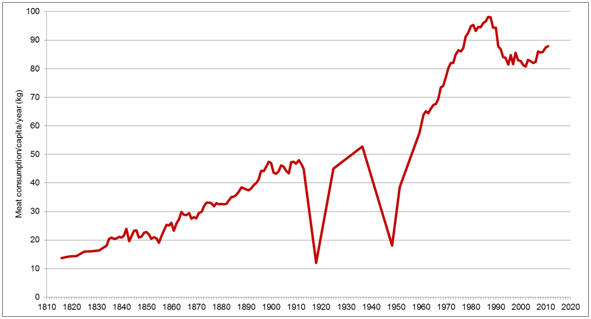
Meat consumption in Germany, 1816–2011
Meat consumption in Germany, 1816–2011
Authors own work. Based on data by: Teuteberg, Hans-Jürgen, and Günter Wiegelmann. Der Wandel der Nahrungsgewohnheiten unter dem Einfluss der Industrialisierung. Göttingen: Vandenhoeck & Ruprecht, 1972; http://www.fao.org/faostat/en/.
This work is used by permission of the copyright holder.
How to cite
Langthaler, Ernst. “Friedrich Haberlandt’s Failed Vision: Soy in European Food Cultures, 1873–1945.” Environment & Society Portal, Arcadia (Spring 2018), no. 3. Rachel Carson Center for Environment and Society. doi.org/10.5282/rcc/8177 (link is external).
ISSN 2199-3408
Environment & Society Portal, Arcadia
 This work is licensed under a Creative Commons Attribution 4.0 International License.
This work is licensed under a Creative Commons Attribution 4.0 International License.
2018 Ernst Langthaler
This refers only to the text and does not include any image rights.
Please click on an image to view its individual rights status.
- Carpenter, Kenneth J. Protein and Energy. A Study of Changing Ideas in Nutrition. Cambridge: Cambridge University Press, 1994.
- Drews, Joachim. Die “Nazi-Bohne.” Anbau, Verwendung und Auswirkung der Sojabohne im Deutschen Reich und Südosteuropa (1933–1945). Münster: Lit-Verlag, 2004.
- Du Bois, Christine M., and Sidney Mintz. “Soy.” In Encyclopedia of Food and Culture, edited by Solomon H. Katz. Vol. 3, 322–26. New York: Scribner, 2003.
- Langthaler, Ernst. “Gemüse oder Ölfrucht? Die Weltkarriere der Sojabohne im 20. Jahrhundert.” In Umkämpftes Essen: Produktion, Handel und Konsum von Lebensmitteln in globalen Kontexten, edited by Ruth Sippel and Cornelia Reiher, 41–66. Göttingen: Vandenhoeck & Ruprecht, 2015.
- Prodöhl, Ines. “Die Dynamiken globaler Vernetzung: Mandschurische Sojabohnen auf dem Weltmarkt.” Zeitschrift für Agrargeschichte und Agrarsoziologie 61 (2013): 75–89.
- Prodöhl, Ines. “Versatile and Cheap: A Global History of Soy in the First Half of the Twentieth Century.” Journal of Global History 8 (2013): 461–482.
- Sorosiak, Thomas. “Soybean.” In The Cambridge World History of Food, edited by Kenneth F. Kiple and Kriemhild Coneè Ornelas. Vol. 1, 422–427. Cambridge: Cambridge University Press, 2000.



